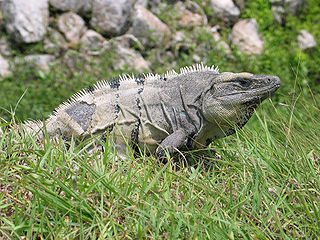
Ctenosaura is a lizard genus commonly known as spinytail iguanas or ctenosaurs. The genus is part of the large lizard family, Iguanidae and is native to Mexico and Central America. The name is derived from two Greek words: ctenos (κτενός), meaning "comb", and saura (σαύρα), meaning "lizard".

Spiny lizards is a common name for the genus Sceloporus in the family Phrynosomatidae. The genus is endemic to North America, with various species ranging from New York, to Washington, and one occurring as far south as northern Panama. The greatest diversity is found in Mexico. This genus includes some of the most commonly seen lizards in the United States. Other common names for lizards in this genus include fence lizards, scaly lizards, bunchgrass lizards, and swifts.

The northern alligator lizard is a species of medium-sized lizard in the family Anguidae. The species is endemic to the North American west coast.

Sceloporus magister, also known as the desert spiny lizard, is a lizard species of the family Phrynosomatidae, native to the Chihuahuan Desert and Sonoran Desert of North America.

Sceloporus poinsettii, the crevice spiny lizard, is a species of small, phrynosomatid lizard.

The granite spiny lizard is a species of lizard in the family Phrynosomatidae.

The Texas spiny lizard is a species of phrynosomatid lizard native to the south central United States, in the states of Texas, Arizona and Oklahoma, and northeastern Mexico in the states of Coahuila, Nuevo León, Tamaulipas, and San Luis Potosí. They are quite common throughout their range, where they can be found in trees or on fences.

Ctenosaura pectinata is a species of moderately large lizard in the family Iguanidae. The species is native to western Mexico.

Sceloporus malachiticus, the emerald swift or green spiny lizard, is a species of small lizard in the Phrynosomatidae family, native to Central America.

The Texas spotted whiptail is a species of long-tailed lizard, in the family Teiidae. The species is endemic to the south central and southwestern United States and northern Mexico. Six subspecies are recognized as being valid.

Sceloporus merriami, commonly known as the canyon lizard, is a species of lizard in the family Phrynosomatidae. The species is native to the south-western United States and northern Mexico.

Sceloporus serrifer, the rough-scaled lizard or Yucatecan rough-scaled lizard, is a species of phrynosomatid lizard.

Sceloporus variabilis, commonly known as the rose-bellied lizard, is a species of lizard which is found from Central America to southern Texas
Sceloporus merriami longipunctatus, commonly known as the Presidio canyon lizard, is a subspecies of the canyon lizard, and is endemic to southwestern Texas and northeastern Mexico. It is unknown if it interbreeds with the other subspecies of canyon lizard found in the same region, but it is likely.
The dunes sagebrush lizard, formerly known as the sand dune lizard and the dunes-sagebrush lizard, Sceloporus graciosus arenicolus, a subspecies of sagebrush lizard), is an insectivorous spiny lizard species which only occurs in the shinnery oak sand dune systems of extreme southeast New Mexico and only four counties in adjacent Texas. Sceloporus arenicolus has the second-smallest range of all lizards in the United States.

The Tamaulipan mezquital is a deserts and xeric shrublands ecoregion in the Southern United States and northeastern Mexico. It covers an area of 141,500 km2 (54,600 sq mi), encompassing a portion of the Gulf Coastal Plain in southern Texas, northern Tamaulipas, northeastern Coahuila, and part of Nuevo León.

Sceloporus jarrovii, also known commonly as Yarrow's spiny lizard, is a species of lizard in the family Phrynosomatidae. The species is native to the southwestern United States and northern Mexico. There are two recognized subspecies.

Sceloporus mikeprestoni, Preston's torquate lizard, is a species of lizard in the family Phrynosomatidae. It is endemic to Mexico.



















